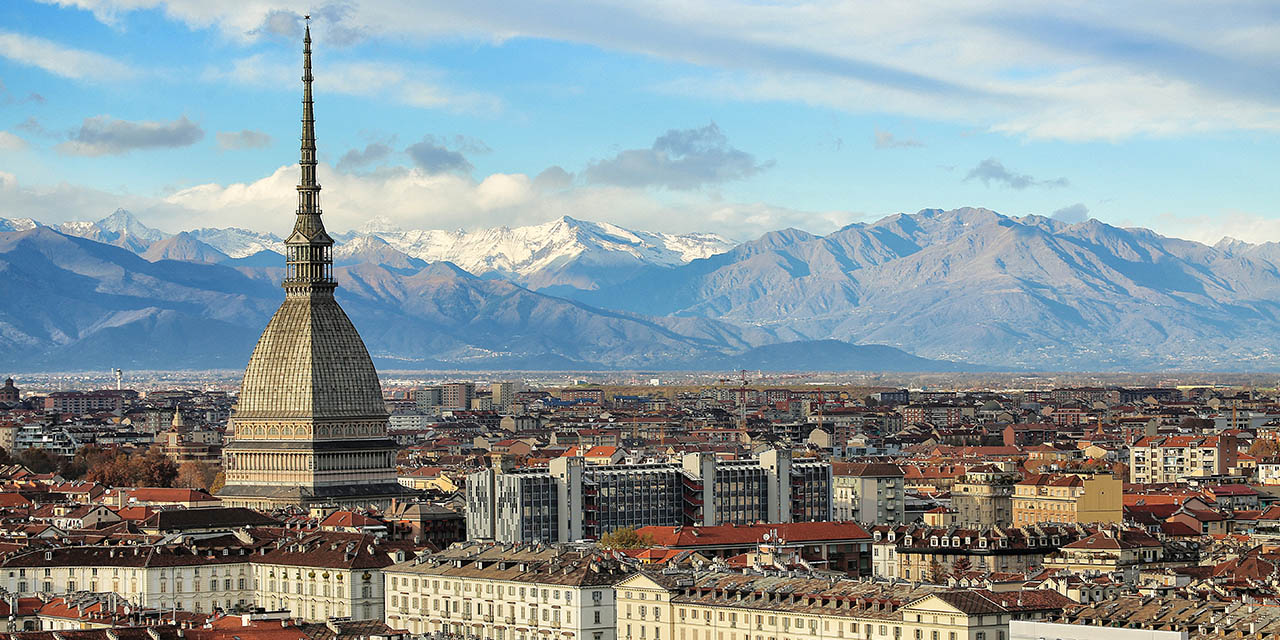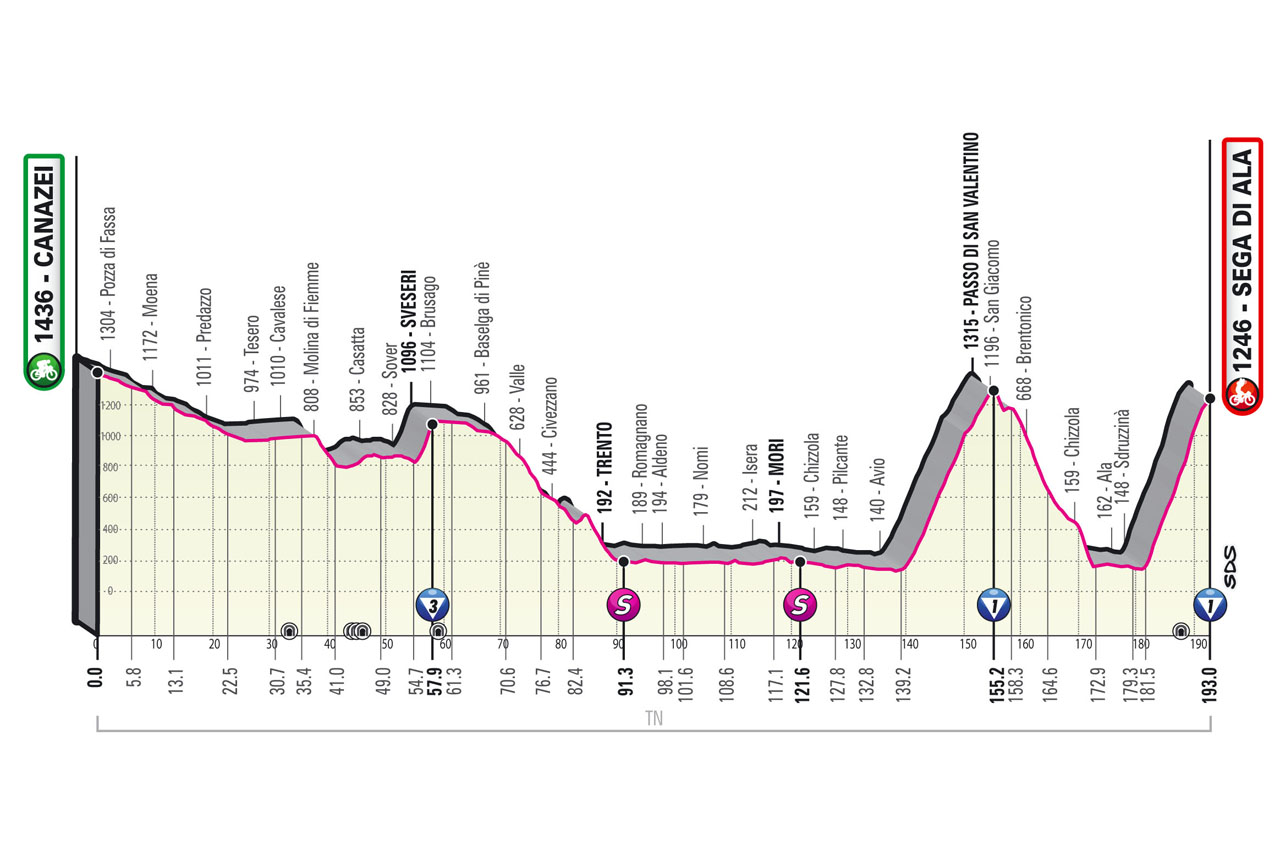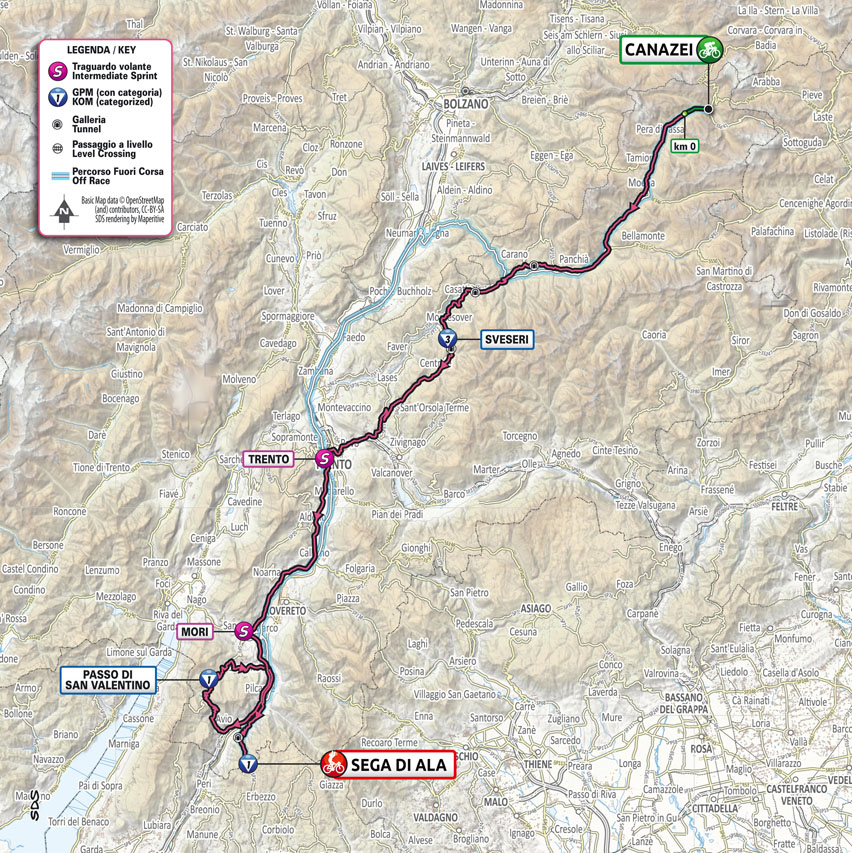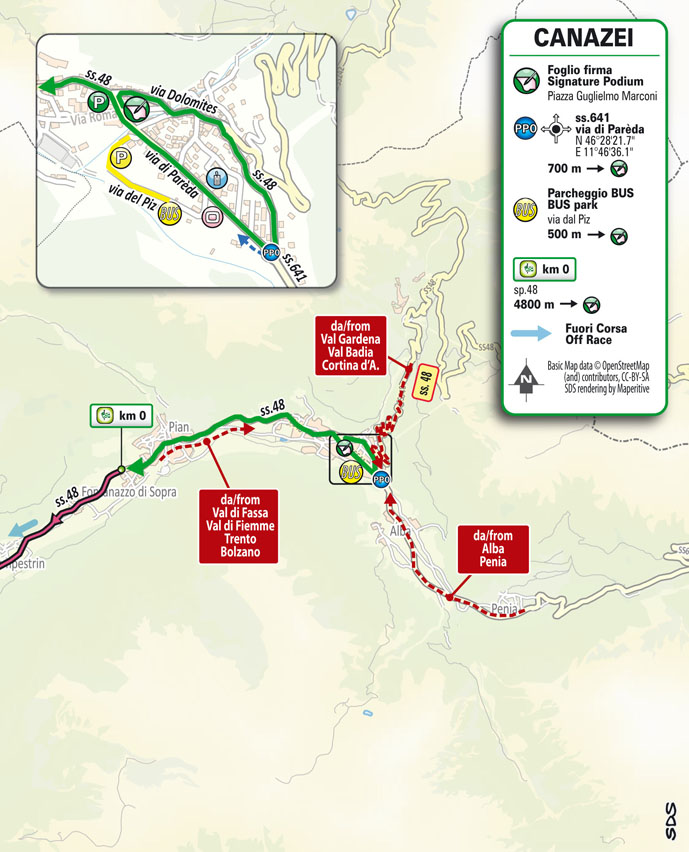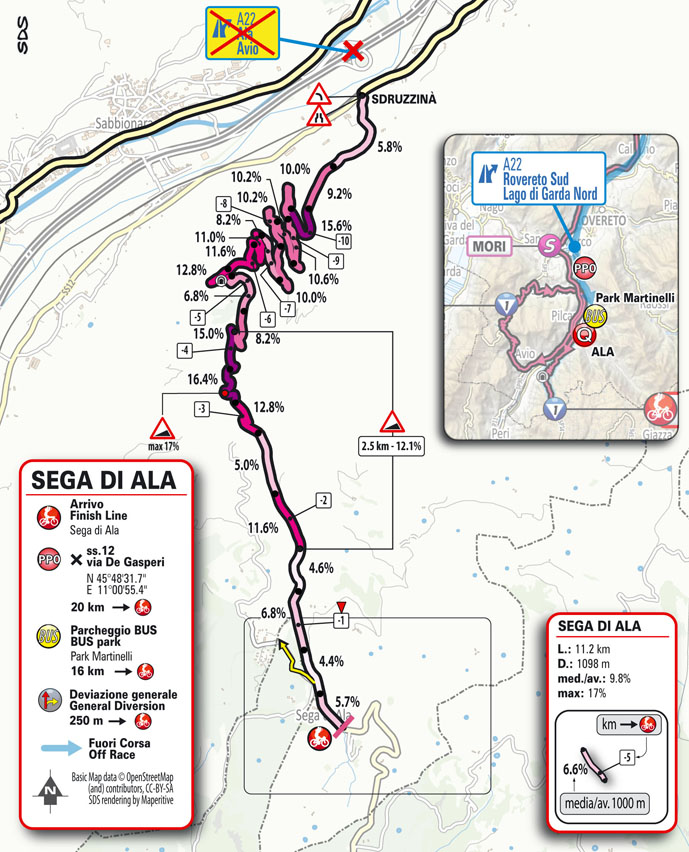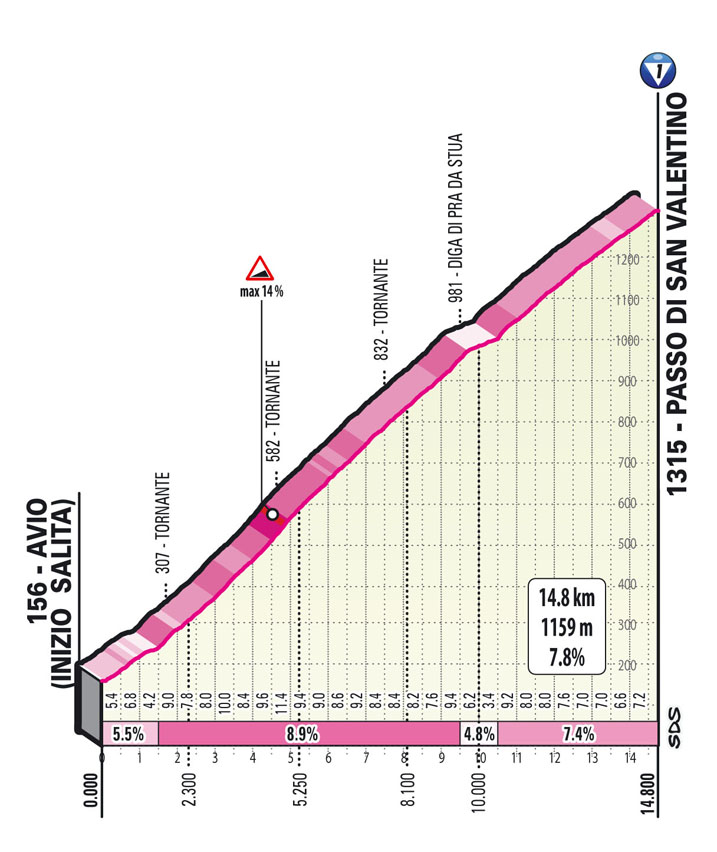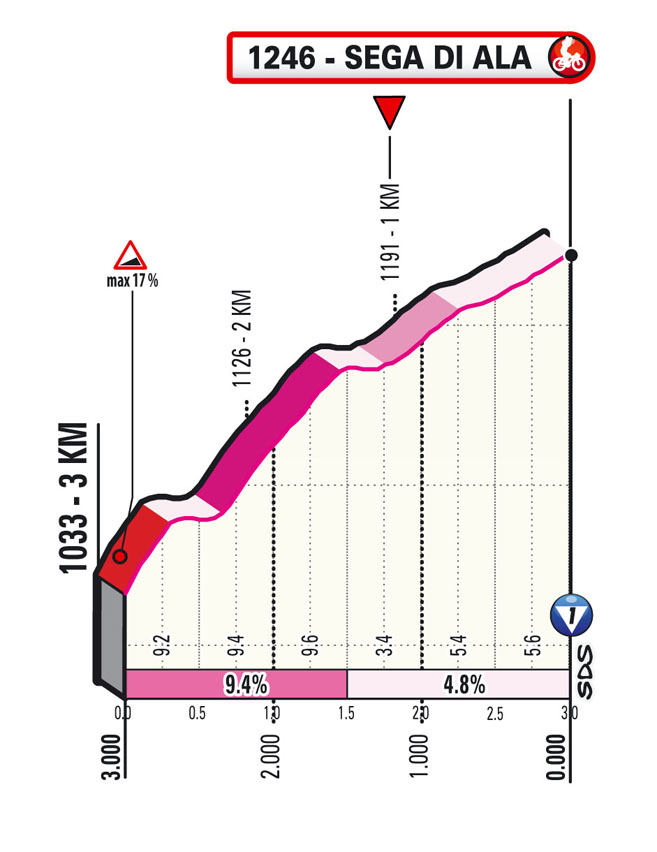profile
map
technical info
This is a high mountain stage running entirely downhill at first, and featuring a summit finish. The route travels the Val di Fassa, the Val di Fiemme and the Pinè plateau all the way to Trento, where it moves to the right bank of the Adige. The course passes through Mori, climbs up to Passo San Valentino (coming from Avio), descends into Chizzola, and moves to the left bank of the Adige in Ala. Past Sdruzzinà, the riders will negotiate the closing climb.
Final kilometres
The final climb is approx. 11 km long. The gradient hovers above 10% for the first 9.5 km, with lengthy peaks exceeding 15% (and topping out at 17-18%). After the last hairpins, leading into the Passo Fittanze plateau, the route continues with milder gradients all the way to the finish line, on tarmac road.
start / finish
climb detail
final kilometres
itinerary timetable
tourist info
Host city:
Canazei
Overview
Among the most renowned centres of the Val di Fassa, Canazei (1456 m) is surrounded by the spectacular Dolomites: the Sella chain (3152 m) overlooks the area, as well as the Gran Vernèl (3058 m) and the Marmolada (3343 m). Crucial for the tourism development of Canazei is the Dolomites Route which has been linking Bolzano to Cortina since 1909, going up through Passo Pordoi too. The municipality includes the hamlets of Alba and Penia, where the road to Passo Fedaia starts.
In summertime, Canazei is the Eden for hikers, on the peaks that have made the history of mountaineering, road cycling, MTB and sky running. In the winter, instead, it is the capital city of skiing, in the middle of the Dolomiti Superski, thanks to ski resorts that are linked with each other by cutting-edge lifts.
The village reflects its ancient economy based on the agriculture and on cattle breeding, with buildings built in wood and stones, gathered around tiny churches which overlook squares and streets that recall a lifestyle in harmony with the nature.
Speciality food
Authentic flavours, simple recipes and top-quality food represent Val di Fassa mouth-watering side. The most seductive aspects of the valley reveal themselves, in fact, on the finest tables of the renowned Ladin restaurants, as well as in the atmosphere of mountain huts and dairies which propose genuine meals by renovating the recipes that have been handed down through the ages. Among the most famous dishes there are the cheeses “Puzzone di Moena Dop” and “Cher de Fascia” (Heart of Fassa), speck and other sorts of cured meat produced by local factories, ensuring the supervision on their goodness, thanks to the short supply chain. Among the traditional dishes we find the “supa da orc” barley soup; “bales”, bread dumplings in broth or with melted butter; “ciajoncie” stuffed ravioli with potatoes and dried figs; pork meat, smoked ribs, pork chop, game meat; speck and other types of cold meat; potatoes, sauerkraut, beetroots, mushrooms and, dulcis in fundo, “fortaes” (fried dough) with cranberry jam, “sones” (apple fritters), Apfelstrudel and Slow Food wildflower honey from the mountains.
Drinks
In Val di Fassa, aperitifs and meals are accompanied by local wines, such as Marzemino, Teroldego, Müller Thurgau, Chardonnay, as well as the Trentodoc mountain bubbles, the Italian classic method sparkling wine. Recently, even the local Val di Fassa beer was born. Its name is “Rampeèer” and it is produced by the namesake craft brewery in Campitello, according to different styles, such as the hell beer, the lager, the low fermentation beer, the dark stout and the Ipa.
Main sights
Through the historical houses (usually painted on the outside with sacred and secular scenes) of Canazei and its suburbs you can find some small churches, such as San Floriano’s church, built in 1570 in gothic style, with a gable roof covered with shingles. Inside, a unique aisle with an apse decorated by a fresco (1912) of Franzeleto Bernard, considered the “Giotto” of Fassa. Also interesting, in the main square Piazza Marconi, the city hall (who had been previously used as elementary school and then Arts school for several years), built at the end of the Twenties by the famous architect Ettore Sottsass senior and renovated and enlarged in 1998. The Never-Ending Trophy is dedicated to the 100th Giro d’Italia (2017): the work is a unique piece and represents the Trophy in bigger scale (a Guinness size) and it is located in the middle of the round-about in Strèda de Pareda. It was made by local craftsmen, from the structure in iron, to the zinc plating, to the outside coating. It doesn’t report the names of the winners of the pink race (as the original one does), but the official logos of the Giro, of the Tourist Board Val di Fassa, of Trentino and the symbol of the Municiplaity of Canazei, which hosted the arrival of a stage on 24th May 2017. On Passo Pordoi, ridden through during 40 stages of the Giro d’Italia since 1940 with the incredible achievements of Gino Bartali and Fausto Coppi, there are both the monument dedicated to this great champion as well as another one realised with a bike gifted by Gilberto Simoni.
Sega di Ala
Overview
Walking through the quiet streets of Ala, in the lower part of Trentino, a few kilometers from Verona, you can breathe a particular atmosphere, with an ancient flavor. The noble palaces, the squares, the courtyards with a Baroque style, in the silence of its narrow streets you can capture the charm of a rich and prestigious past. It is said that in the mid-1600s two Genoese refugees, who arrived by chance in Vallagarina, settled in Ala to practice the profession of velvet weavers, an art in which they were very skilled masters. Thus was born the first velvet factory, which gave way to a flourishing craftsmanship and trade that made Ala famous throughout Europe.
Renamed “City of Velvet” in the eighteenth century, in 2007 it received the “Orange Flag” of the Italian Touring Club. Its elegant historic center, one of the most well-preserved in Trentino, comes alive in the summer during the event “City of Velvet”. The palaces and gardens are open to visitors, hundreds of figures in period costume enliven the streets and squares, music, shows and poetry relieve the glories of the eighteenth century.
Speciality food
In addition to refined wines, Vallagarina is also known for its quality products, which give an original and tasty touch to the table. Soft or seasoned malga cheeses, with a delicate or pungent taste, each with unique characteristics, the result of different techniques and flavors that have been handed down for a long time. The organic vegetables of Val di Gresta, among the first valleys in Italy to devote itself to organic, first of all: cabbage, carrot, celeriac and potato. Medicinal herbs such as mint, lemon balm, calendula, cornflower and mallow, used both in food and in cosmetics. The most valuable of the species present in the area is certainly the Baldo saffron, which is obtained from the flowers of the Crocus Sativus, characterized by an unmistakable yellow color, an intense aroma and a strong flavor. Cereals such as wheat and buckwheat, wheat, sorghum, rye, oats and barley. The meats and cured meats: many butchers and farms in the city and in the small villages continue in the tradition of producing, each with its own recipes, luganega (salami from the Trentino valleys) and other typical cured meats. Castione chestnuts, from which unique recipes and products are born, such as chestnut tagliolini, chestnut beer, and the famous Marroncino di Castione.
Drinks
Trentino is one of the mountain wine-growing areas which is deeply linked to the territory and offers wines of identity. Here, touched by the Adige River, ventilated and protected by important mountains such as the Little Dolomites, is Vallagarina. A valley that has extremely favorable conditions for viticulture. Among plains, hills, terraces and the steep slopes of the side valleys, Vallagarina produces great wines, from the classic method to the whites up to the full-bodied red wines, among which the native Marzemino, Casetta and Enantio stand out. In Vallagarina, in addition to wine, a new generation of craft beers is making its way, fermented and aged in barrels with grapes or grape must, or sparkling with the classic method directly in the bottle. Another important role is played by single-variety grappas, obtained from the pomace of a usual grape quality, such as “Grappa al Marzemino” and “Moscato”, or flavored grappas for infusion such as Grappa alla Ruta, all’Ortica, and Hay. For those who prefer the simple flavors of fruit to alcoholic beverages, an ancient tradition is that of preparing fruit juices and syrups based on raspberry, elderberry, blueberry or black cherry.
Main sights
Crossing the historic center with 18th-century costumed figures is the best way to experience the history of one of the most elegant villages in Trentino. “City of Velvet” and “City of Music”: the deepest roots of Ala, which has always been a transit area, have their roots in these two arts. Palazzo Taddei, with its splendid loggia and austere facade is the oldest building in Ala and will become the seat of the Provincial Textile Museum. In the halls of Palazzo De ‘Pizzini, the Antique Piano Museum will soon exhibit a prestigious collection of pianos from the time of Mozart, Schubert, Beethoven and Chopin.
In a dominant position over the historic center, you can see the Parish Church of Santa Maria Assunta, of ancient origins and north of the city, along the path that runs along the ancient “Roman road”, stands the majestic sanctuary of San Valentino, an ancient place of worship. A few kilometers from Ala, along the provincial road that leads to Verona, is the ancient Romanesque church of San Pietro in Bosco while in Serravalle, a memorial stone is placed in memory of the exact place where, on 29 October 1918, the Habsburg army asked the suspension of the fighting.
From the locality Sega di Ala, the landscape turns into a gentle plateau with large meadows, beech woods and alpine huts with characteristic stone roofs, still used today for cattle mountain pasture. It is a particular and unique environment both from a geomorphological, landscape, historical and environmental point of view. The karst phenomena have shaped the landscape, typical are the “cronelle”, stratified rock formations of stone that emerge from the meadows, creating an evocative and unforgettable landscape.
The Lessinia plateau allows outdoor lovers to immerse themselves in an atmosphere rich in peasant traditions, flavors and history. For a trekking in the places of the Great War, a walk to the “Busoni” is recommended, a series of tunnels built by the Italian Army, entirely dug into the rock of Cima Borghetto. For excursions on the “Little Dolomites”, the starting point is the Ronchi Valley. At the entrance to the valley, a suggestive walk also leads to an ancient forge along the Ala stream.











